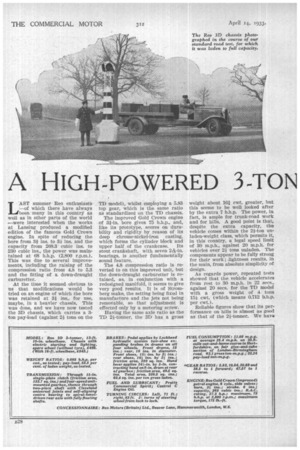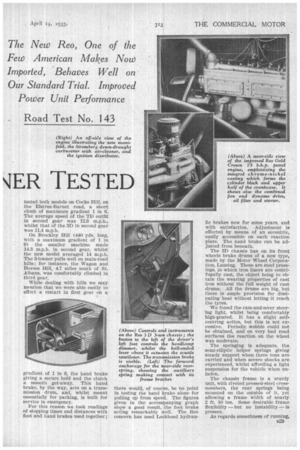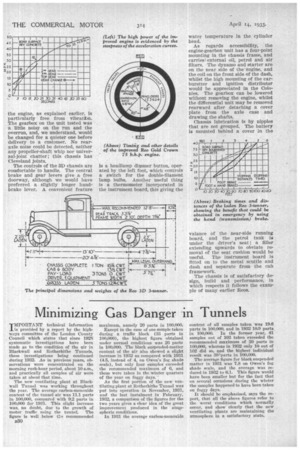A HIGH-POWERED 3-TON
Page 42

Page 43

Page 44

If you've noticed an error in this article please click here to report it so we can fix it.
■ IER TESTED
L• 'AST summer Reo enthusiasts —of which there have always been many in this country as well as in other parts of the world —were interested when the works at Lansing produced a modified edition of the famous Gold Crown engine. In spite of reducing the bore from 3f ins. to 3* ins, and the capacity from 268.3 cubic ins. to 230 cubic ins., the power was maintained at 68 b.h.p. (2,800 r.p.m.). This was due to several improvements, including the raising of the compression ratio from 4.8 to 5.3 and the fitting of a down-draught carburetter.
At the time it seemed obvious to us that modifications would be tried on an engine of which the bore was retained at 3f ins., for use, maybe, in a heavier chassis. This was done, and we have now tested the 3D chassis, which carries a 3ton pay-load (against 21 tons on the TD model), whilst employing a 5.83 top gear, which is the same ratio• as standardized -on the TD chassis.
The improved Gold Crown engine of 31-in. bore gives 75 b.h.p., and, like its prototype, scores on ultrability and rigidity by reason of its deep chrome-nickel-iron casting, which forms the cylinder block and
upper half of the crankcase. Its stout crankshaft, with seven 21-in. bearings, is another fundamentally sound feature.
The 4.8 compression ratio is reverted to on this improved unit, but the down-draught carburetter is retained, as, in conjunction with a redesigned manifold, it seems to give very good results. it Is of Stromberg make, the setting being fixed in manufacture and the jets not being removable, so that adjustment is effected only by a metering screw.
Having the same axle ratio as the TO 2*-tonuer, the 3D has a gross
weight about 161 cwt. greater, but this seems to be well looked after by the extra 7 b.h.p. The power, in fact, is ample for trunk-road work and for hills. A good point is that, despite the extra capacity, the vehicle comes within the 2i-ton -Unladen-weight class, which permits it, in this country, a legal speed limit of 30 m.p.h., against 20 m.p.h. for vehicles over 2)t tons unladen. The components appear to be fully strong for their work ; lightness results, in the main, from absolute simplicity of design.
As regards power, repeated tests showed that the vehicle accelerates from rest to 30 m.p.h. in 22 sees., against 20 secs. for the TD model with a gross weight of 4 tons 15* cwt. (which means 0.712 b.h.p. per cwt.).
Reliable figures show that its performance on hills is almost as good as that of the 21-tonner. We have tested both models on Cocks Hill, on the Elstree-Barnet road, a short climb of maximum gradient 1 in 6. The average speed of the TD outfit in second gear was 12.3 m.p.h., whilst that of the 3D in second gear was 11.4 m.p.h.
On Brockley Hill (440 yds. long, with a maximum gradient of 1 in 9) the smaller machine made 14.3 m.p.h. in second gear, whilst the new model averaged 14 m.p.h. The 3-tonner pulls well on main-road hills; for instance, the Wagon and Horses Hill, 4.7 miles south of St. Albans, was comfortably climbed in third gear.
While dealing with hills we may mention that we were able easily to effect a restart in first gear on a gradient of 1 in 6, the hand brake giving a secure hold and the clutch a smooth get-away. This had brake, by the way, acts on a transmission drum, and, whilst meant essentially for parking, is built for service in emergency.
For this reason we took readings of stopping times and distances with • foot and hand brakes used together ;
(Above) Controls and instruments on the Reo 3 D 3-ton chassis ; the button to the left of the driver's left foot controls the headlamp dimmer, whilst the ball-ended lever above it actuates the scuttle v,entilator. The transmission brake is visible. (Left) The forward anchorage for the near-side rearspring, showing the auxiliary spring making contact with its
there would, of course, he no point in testing the hand brake alone for pulling up from speed. The figures given in the accompanying graph show a good result, the foot brake acting remarkably well. The Reo concern has used Lockheed hydrau
lie brakes now for some years, and with satisfaction. Adjustment is effected by means of an eccentric, easily accessible on each reaction plate. The hand brake can be adjusted from beneath.
The 3D chassis has on its front wheels brake drums of a new type, made by the Motor Wheel Corporation, Lansing. These are steel pressings, in which iron liners are centrifugally east, the object being to obtain the wearing properties of cast iron without the full weight of east drums. All the drums are big, but there is ample provision for dissipating heat without letting it reach the tyres.
We found the cam-and-lever steering light, whilst being comfortably high-geared. It has a slight selfcentring action, but this is not excessive. Periodic wobble could not be obtained, and on very bad road surfaces the reaction on the wheel was moderate.
The springing is adequate, the semi-elliptic helper springs giving steady support when three tons are carried and when severe shocks are experienced, whilst affording a light suspension for the vehicle when unladen.
The chassis frame is a 'sturdy unit, with riveted pressed-steel crossmembers, the rear springs being mounted on the outside of it, yet allowing a frame width of nearly 2 ft. 10 ins. Some desirable frame flexibility — but no instability —is present.
As regards smoothness of running, u29 the engine, as explained earlier. is particularly free from vibratbn. The gearbox on the unit tested was a little noisy on the run and the overrun, and, we understand, would be changed for a quieter one before delivery to a customer. No rearaxle noise could be detected, neither any propeller-shaft whip nor universal-joint chatter; this chassis has Cleveland joints.
The controls of the 3D chassis are comfortable to handle. The central brake and gear levers give a free doorway, although we would have preferred a slightly longer handbrake lever. A convenient feature water temperature in the cylinder head.
As regards accessibility, the engine-gearbox unit has a four-point mounting in the chassis frame, and carries; external oil, petrol and air filters. The dynamo and starter are on the near side of the' engine, and the coil on the front side of the dash, whilst the high mounting of the carburetter and ignition distributor would be appreciated in the Cobflies. The gearbox can be lowered without removing the engine, whilst the differential unit may be removed rearward after detaching a cover plate from the axle case and drawing the shafts.
Chassis lubrication is by nipples that are not grouped. The battery is mounted behind a cover in the
valance of the near-side running board, and the petrol tank is under the driver's seat ; a filler extending upwards to obviate removal of the seat cushion would be useful. The instrument board is fitted on to the metal scuttle and dash and separate from the cab framework.
The chassis is of satisfactory design, build and performance, in Which respects it follows the example of many earlier Reos.




























































































